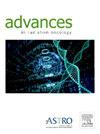尤因肉瘤的最终放射治疗:基于肿瘤体积、剂量和分离的结果
IF 2.7
Q3 ONCOLOGY
引用次数: 0
摘要
目的:对较大的尤文氏肉瘤(ESs)进行终期放射治疗(DE-RT)的剂量递增与局部复发风险降低相关。我们报告了用DE-RT治疗ES肿瘤的治疗和毒性结果,包括低分割方法和大小分层分析。方法与材料回顾性分析接受DE-RT治疗剂量≥55.8 Gy的ES患者。局部衰竭(LF)与死亡作为竞争风险进行评估。使用最大选择的秩统计来确定患者的最佳分层,通过肿瘤大小测量生存。结果共分析47例患者。28例(59.6%)患者接受了DE-RT,其中6例接受了低分割。对于DE-RT, α/β = 10的2 Gy分数中位等效剂量为常规分割60 Gy(范围56.2-62),低分割62.2 Gy(范围56.5-67.1)。根据经验得出的大小临界值确定了一个具有较高LF风险的超大肿瘤亚组,其最长方向为11.8 cm,化疗前体积为569.2 cm3,化疗后体积为288.9 cm3。接受DE-RT治疗的患者5年累积LF发病率较低,为11.7% (95% CI, 3.16%-43.6%),而非DE-RT治疗的患者为35.6% (95% CI, 17.4%-72.61%;P = .098)。多变量分析显示DE-RT对所有大小和分期的肿瘤都有利。结论在所有肿瘤中,de - rt均与LF改善的趋势相关,且无毒性或计划质量改变。超大肿瘤的LF发生率较低,需要进一步研究。本文章由计算机程序翻译,如有差异,请以英文原文为准。
Definitive Radiation Therapy for Ewing Sarcoma: Outcomes Based on Tumor Volume, Dose, and Fractionation
Purpose
Dose escalation for definitive radiation therapy (DE-RT) in larger Ewing sarcomas (ESs) is associated with a lower risk of local recurrence. We report treatment and toxicity outcomes in ES tumors treated with DE-RT, including hypofractionated approaches and size stratification of analysis.
Methods and Materials
A retrospective review of ES patients treated with DE-RT to doses ≥55.8 Gy was performed. Local failure (LF) with death as a competing risk was assessed. Maximally selected rank statistics were used to determine the optimal stratification of patients by survival using tumor size measurements.
Results
In total, 47 patients were analyzed. Twenty-eight patients (59.6%) received DE-RT, of which 6 received hypofractionation. For DE-RT, median equivalent dose in 2 Gy fraction for α/β = 10 was 60 Gy (range, 56.2-62) with conventional fractionation and 62.2 Gy (range, 56.5-67.1) with hypofractionation. Empirically derived size cutoffs identified a subgroup of ultralarge tumors at higher risk of LF defined as >11.8 cm in the longest direction, 569.2 cm3 prechemotherapy volume, or 288.9 cm3 postchemotherapy volume. Five-year cumulative incidence of LF was lower in patients treated with DE-RT at 11.7% (95% CI, 3.16%-43.6%) versus 35.6% for non-DE-RT (95% CI, 17.4%-72.61%; P = .098). Multivariate analysis showed trends toward DE-RT benefiting tumors of all sizes and stages.
Conclusions
DE-RT was associated with a trend toward better LF in all tumors without toxicity or plan quality changes. Ultralarge tumors demonstrated poor LF rates and necessitate further study.
求助全文
通过发布文献求助,成功后即可免费获取论文全文。
去求助
来源期刊

Advances in Radiation Oncology
Medicine-Radiology, Nuclear Medicine and Imaging
CiteScore
4.60
自引率
4.30%
发文量
208
审稿时长
98 days
期刊介绍:
The purpose of Advances is to provide information for clinicians who use radiation therapy by publishing: Clinical trial reports and reanalyses. Basic science original reports. Manuscripts examining health services research, comparative and cost effectiveness research, and systematic reviews. Case reports documenting unusual problems and solutions. High quality multi and single institutional series, as well as other novel retrospective hypothesis generating series. Timely critical reviews on important topics in radiation oncology, such as side effects. Articles reporting the natural history of disease and patterns of failure, particularly as they relate to treatment volume delineation. Articles on safety and quality in radiation therapy. Essays on clinical experience. Articles on practice transformation in radiation oncology, in particular: Aspects of health policy that may impact the future practice of radiation oncology. How information technology, such as data analytics and systems innovations, will change radiation oncology practice. Articles on imaging as they relate to radiation therapy treatment.
 求助内容:
求助内容: 应助结果提醒方式:
应助结果提醒方式:


